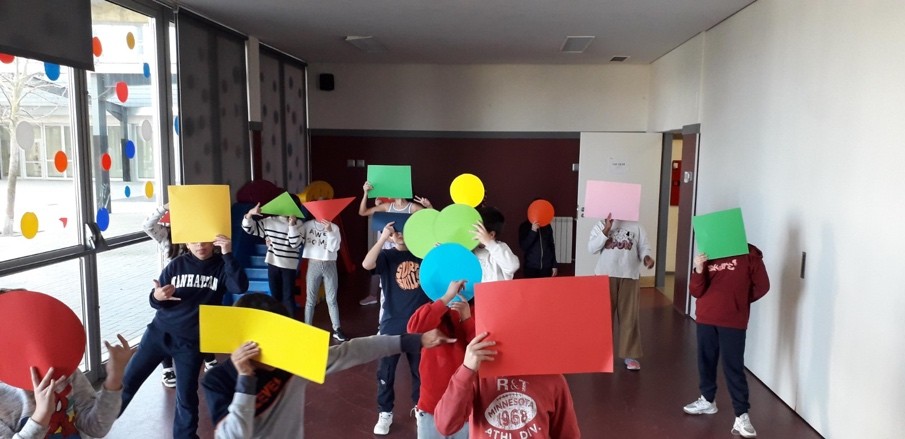"Trocoscopio"
Institution
Agrupamento de Escolas Miguel Torga
Institution Typology
School
Country
Portugal
Stakeholders involved
Primary teachers and students
Parents
School library
Border schools project
Summary
This activity originated from the book Trocoscópio, by Bernardo Carvalho. It involved experiences with light, the construction of a kaleidoscope, cutting and assembling visual compositions with colorful geometric figures, and attribution of narrative meanings. Mathematical problems were solved with concepts of spatial orientation, seriation and counting. To end it, the students created free choreographies, expressing themselves bodily and artistically. Digital tools were used in the creation of patterns and visual sequences. The activity promoted creativity, empathy, expression, critical thinking and respect for cultural diversity.
CONTEXT AND OBJECTIVES
Problem addressed or learning needs
The learning needs developed were:
• To develop skills of creative expression, empathy, image reading and intercultural awareness.
• To promote computational thinking through the creation of visual patterns and sequences, with optional use of digital tools (such as visual composition or kaleidoscope simulation apps).
And the types of learning addressed were:
Cognitive: visual interpretation, spatial organization, construction of narratives
Metacognitives: self-reflection, respect for differences, empathy
Collaborative: group work, active listening, sharing of interpretations
Types of enhanced competences
• Visual and written literacy
• Critical and creative thinking
• Artistic and bodily expressiveness
• Mathematical skills (shapes, patterns, orientation)
• Educational use of digital tools
• Respect for linguistic and cultural diversity
METHODS, STRATEGIES AND TOOLS
Subjects involved
Humanities, Technologies\Engineering, Math, Natural Science, Civic education, Foreign Languages, Arts
Duration and timeline of implementation
During a term, two hours per week
Strategies and activities
Reading images from the book "Trocoscope"
Exploration of scientific concepts (light, shadow, symmetry)
Kaleidoscope construction (simple engineering)
Cutting and assembling colorful geometric shapes
Creation of narratives from compositions
Troubleshooting Counting and Spatial Orientation
Free choreographic composition to the sound of music
Use of digital tools (pattern apps, kaleidoscope simulation, visual storytelling)
Material Sources
Computers/tablets with visual apps
Methodology
Team Work, Cooperative Learning, Storytelling, Learning By Doing, Inquiry-Based Learning, Technology-Enhanced Active Learning (Teal)
IMPACT AND RESULTS
Impact
n. of students involved – 211 primary students
n. of teachers involved: 20
n. of schools involved – 1
Observed Benefits
• More fluent and creative oral and written expression
• Improved spatial and mathematical problem solving
• Meaningful exploration of visual and body language
• Development of empathy and respect for diversity
• Increased interest in science and art in an integrated way
Challenges Faced
• Logistical requirement (materials, time...)
• • Strong emotional and creative involvement of students
• Interdisciplinary approach
• Integration of artistic expression with science and mathematics
• Exploration of digital tools and visual/musical stimuliTeacher training for the integration of digital tools
LESSONS LEARNT AND RECOMMENDATIONS
Key Success Factors
• Strong emotional and creative involvement of students
• Interdisciplinary approach
• Integration of artistic expression with science and mathematics
• Exploration of digital tools and visual/musical stimuli
Future Improvements
• Expand the activity with design and simulation software
• Produce videos or podcasts of the stories created
• Explore partnerships with local artists
• Create a digital repository of student work
Recommendations
• Replicate the practice with a focus on cultural/local personalization
• Use the activity as a tool for inclusion (multicultural classes)
• Integrate Scratch programming into the creation of sequences and patterns
• Promote teacher training in creative STEAM methodologies

